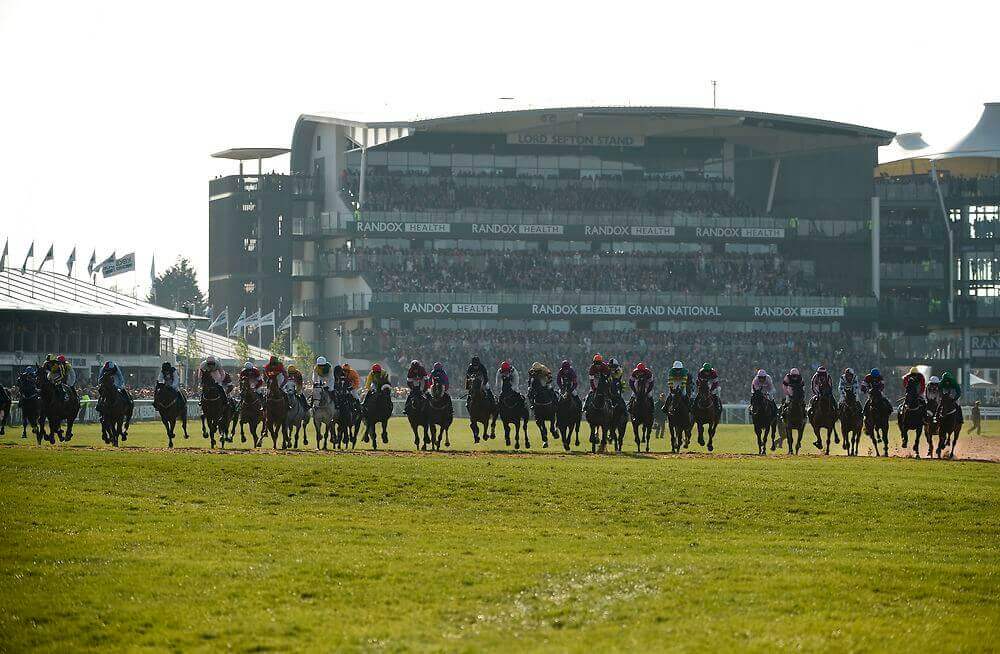What Will The Ground Be Like At Aintree This Year?

RACING-ENG-NATIONAL Jockeys ride their horses after starting the Grand National Handicap Chase horse race on the final day of the Grand National Festival at Aintree Racecourse in Liverpool, north west England on April 6, 2019. Tiger Roll put his name alongside legend Red Rum on Saturday winning back to back Grand Nationals in stunning style. The 4-1 favourite, superbly ridden by Davy Russell, took up the running at the last fence and although 66-1 outsider Magic of Light came back at him the nine-year-old had enough to spare to emulate Red Rums feat in 1973-74. Oli SCARFF / AFP
Storms Ciara and Dennis have had a big impact on the horse racing calendar this winter, with many fixtures being forced to abandon their meetings.
Those cards which have managed to survive have predominately been run on heavy ground, which has been testing for the majority of horses which have featured.
If the rain continues to fall from now until April, the Grand National may well be run on soft or heavy ground, making the marathon contest even more difficult.
Here is a look back at three races where the ground has ended up on the extreme side.
Mr Frisk breaks record time on firm ground in 1990
It is very rare to see the term Firm in the going report in National Hunt racing but due to a prolonged period of dry weather leading up to the 1990 Grand National, that is exactly what the going was that year.
Mr Frisk won the race and in doing so broke the record time for the steeplechase at eight minutes and 47.8 seconds. That time was 14.10 seconds quicker than the previous best which was set by Red Rum in 1973 in the first of his three victories.
Kim Bailey’s runner was ridden to success by amateur jockey Marcus Armytage. He prevailed by just three-quarters of a length as Durham Edition also ran a fantastic race in second place.
There were 20 finishers that year as most horses found getting the trip much easier than they would have if the ground would have been on the soft side.
Earth Summit wins on Heavy going in 1998
Only six horses finished the 1998 Grand National as heavy conditions meant it was a real slog for the 36 runners which lined up in Liverpool.
The heavy ground was always going to suit Earth Summit who was known for his stamina. Nigel Twiston-Davies’ horse had won the Scottish Grand National and Welsh Grand National prior to that race so had no problem with the testing ground.
Earth Summit was subject to a huge gamble on the day of the race as the rain fell and it became evident that the ground would end up heavy. He started as the 7/1 favourite and proved a popular winner due to the weight of money behind him.
Ridden by Carl Llewellyn, the pair prevailed by 11 lengths in a time of 10 minutes and 51.5 seconds.
Ballabriggs scores in sweltering conditions in 2011
2011 Grand National day was known for being one of the hottest days that the world’s most famous steeplechase has been run on.
The official ground was Good (Good to Soft in places) in the contest which was won by Ballabriggs for trainer Donald McCain Jr, continuing the family’s rich association with the Aintree contest.
After winning the race, Ballabriggs returned straight to the stables rather than being paraded in the winner’s enclosure due to the heat. The team at Aintree did a great job of ensuring all the horses were hydrated properly after the race.
Ballabriggs was splashed with a number of buckets of water to help bring his body temperature down. Since then, the 2017 renewal has come close to those temperatures, however, it really was unseasonally hot weather for April in 2011.




